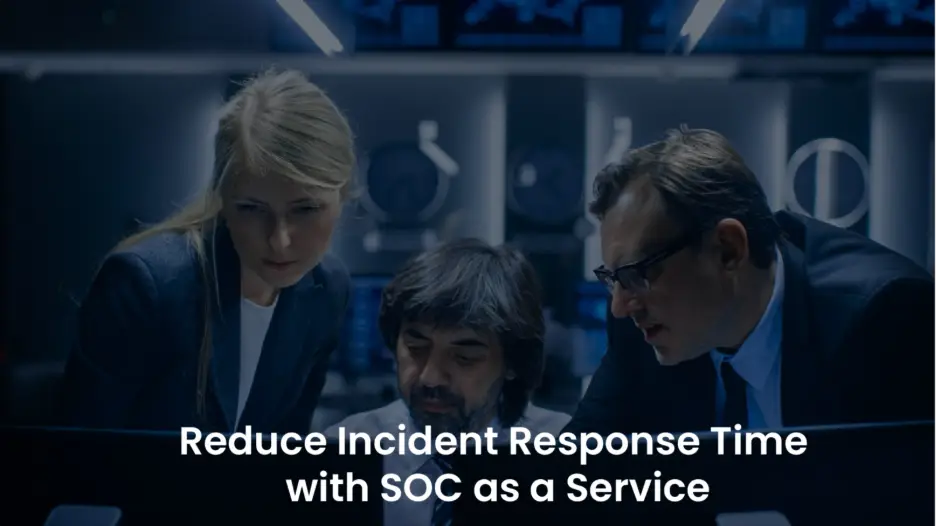
Before delving into the intricacies of SOC as a Service (SOCaaS), it is essential to first grasp the fundamentals of a Security Operations Center (SOC), including its vital functions, capabilities, and the crucial role it plays in protecting an organisation’s digital infrastructure. This foundational knowledge underscores the importance of SOCaaS.
This article explores how SOC as a Service significantly reduces incident response time by examining its relevance, best practices, and critical metrics such as MTTD (Mean Time to Detect) and MTTR (Mean Time to Respond). It elaborates on how SOCs ensure continuous monitoring, implement automated triage, and coordinate responses across cloud and endpoint environments. Additionally, it discusses how integrating SOCaaS with existing security stacks enhances visibility and fortifies cybersecurity resilience. Readers will gain valuable insights into how a robust SOC strategy, regular drills, and comprehensive threat intelligence can lead to quicker containment of threats, alongside the benefits of employing managed SOC services to tap into expert analysts, advanced tools, and scalable processes without the necessity of developing these capabilities internally.
Effective Strategies to Minimise Incident Response Time with SOC as a Service
To successfully minimise incident response time through SOC as a Service (SOCaaS), organisations must align technology, processes, and expert knowledge to quickly identify and mitigate potential threats before they escalate into serious issues. A reliable managed SOC provider integrates ongoing monitoring, cutting-edge automation, and a skilled security team to enhance each stage of the incident response lifecycle, ensuring that every aspect works in harmony to bolster organisational security.
A Security Operations Center (SOC) functions as the central command centre for an organisation’s cybersecurity framework. When delivered as a managed service, SOCaaS merges essential components such as threat detection, threat intelligence, and incident management into a cohesive structure. This integration empowers organisations to respond to security incidents in real time, thereby enhancing their overall security posture and resilience against cyber threats.
Efficient methods for reducing response time include:
- Continuous Monitoring and Detection: By leveraging advanced security tools and SIEM (Security Information and Event Management) platforms, organisations can analyse logs and correlate security events across a multitude of endpoints, networks, and cloud services. This real-time monitoring offers a comprehensive perspective on emerging threats, significantly lowering detection times and aiding in the prevention of potential breaches.
- Automation and Machine Learning: SOCaaS platforms harness the capabilities of machine learning to automate routine triage tasks, prioritise critical alerts, and initiate predefined containment strategies. This automation diminishes the time that security analysts dedicate to manual investigations, facilitating quicker and more efficient responses to incidents, ultimately enhancing overall security effectiveness.
- Skilled SOC Team with Clearly Defined Roles: A managed response team consists of experienced SOC analysts, cybersecurity experts, and incident response specialists who operate with well-defined roles and responsibilities. This structured approach ensures that every alert receives prompt and appropriate attention, thereby enhancing the efficiency of overall incident management.
- Integrated Threat Intelligence and Proactive Hunting: Proactive threat hunting, bolstered by global threat intelligence, facilitates the early detection of suspicious activities, thereby minimising the risk of successful exploitation and strengthening incident response capabilities. This proactive stance is essential for maintaining robust security measures in an ever-evolving threat landscape.
- Unified Security Stack for Improved Coordination: SOCaaS consolidates various security operations, threat detection, and information security functions under a single provider. This integration enhances coordination among security operations centres, resulting in swifter response times and a reduced duration for resolving incidents, thereby improving the overall security framework of the organisation.
Why is SOC as a Service Indispensable for Reducing Incident Response Time?
Here’s why SOCaaS is essential:
- Continuous Visibility: SOC as a Service provides real-time visibility across endpoints, networks, and cloud infrastructures. This allows for the early identification of vulnerabilities and unusual behaviours before they develop into significant security breaches, thereby greatly enhancing the overall security posture of the organisation.
- 24/7 Monitoring and Rapid Response: Managed SOC operations operate continuously, meticulously reviewing security alerts and events. This constant vigilance guarantees prompt incident responses and swift containment of cyber threats, ultimately improving the organisation's overall security posture and readiness to handle potential attacks.
- Access to Expert Security Teams: Partnering with a managed service provider grants organisations access to highly trained security experts and incident response teams. These professionals can effectively assess, prioritise, and respond to incidents in a timely manner, alleviating the financial burden associated with maintaining an in-house SOC while ensuring top-notch security measures.
- Automation and Integrated Security Solutions: SOCaaS integrates advanced security solutions, analytics, and automated response playbooks, streamlining incident response strategies. This integration significantly reduces delays caused by human intervention in threat analysis and remediation, ensuring a more efficient response to potential cyber threats.
- Enhanced Threat Intelligence Capabilities: Managed SOC providers leverage global threat intelligence to proactively anticipate emerging risks within the continually evolving threat landscape. This proactive approach fortifies an organisation’s defences against potential cyber threats, ensuring that security measures are always one step ahead of adversaries.
- Improved Overall Security Posture: By fusing automation with expert analysts and scalable infrastructure, SOCaaS empowers organisations to maintain a resilient security posture, effectively addressing contemporary security demands without overburdening internal resources.
- Strategic Alignment for Enhanced Focus: SOC as a Service enables organisations to concentrate on strategic security initiatives while the third-party provider manages daily monitoring, detection, and threat response activities. This effectively reduces the mean time to detect and resolve incidents, ensuring that security operations are both effective and efficient.
- Real-Time Management of Security Incidents: Integrated SOC monitoring and analytics provide a comprehensive overview of security events, enabling managed security services to identify, respond to, and recover from potential security incidents with remarkable efficiency, thus safeguarding the organisation's valuable assets.
What Best Practices Enhance Incident Response Time with SOCaaS?
Here are the most effective practices to consider:
- Establish a Comprehensive SOC Strategy: Clearly define structured processes for detection, escalation, and remediation. A well-articulated SOC strategy ensures that each phase of the incident response process is executed efficiently across various teams, significantly enhancing overall effectiveness and reducing the likelihood of oversight during critical events.
- Implement Continuous Security Monitoring: Ensure 24/7 security monitoring across all networks, endpoints, and cloud environments. This proactive strategy facilitates early detection of anomalies, which significantly reduces the time required to identify and contain potential threats before they escalate into major incidents.
- Automate Incident Response Workflows for Greater Efficiency: Integrate automation within SOC solutions to expedite triage, analysis, and remediation processes. This automation minimises the need for manual intervention while simultaneously enhancing the overall quality of response operations, leading to swifter resolutions and improved security outcomes.
- Leverage Managed Cybersecurity Services for Seamless Scalability: Collaborating with specialised cybersecurity service providers allows organisations to scale their services effortlessly, ensuring expert-led threat detection and mitigation without the operational challenges associated with maintaining an in-house SOC. This flexibility is vital in adapting to changing security needs.
- Conduct Regular Threat Simulations for Enhanced Preparedness: Carry out simulated attacks, such as DDoS (Distributed Denial of Service) drills, to assess an organisation’s security readiness. These simulations help identify operational gaps and refine the incident response process, thereby enhancing overall resilience and readiness to counter real-world threats.
- Enhance Data Security and Visibility Across Systems: SOCaaS platforms consolidate telemetry from various systems, offering unified visibility into network, application, and data security layers. This comprehensive perspective greatly shortens the time between detection and containment of threats, ensuring that organisations can respond effectively to security incidents.
- Integrate SOC with Existing Security Tools for Cohesion: Align current security tools and platforms within the managed SOC ecosystem to eliminate silos and enhance overall security outcomes. This fosters a more collaborative security environment, ensuring that different security functions work seamlessly together to tackle threats.
- Adopt Solutions Compliant with Industry Standards: Partner with reputable vendors, such as Palo Alto Networks, to incorporate standardized security solutions and frameworks that enhance interoperability while reducing the likelihood of false positives, thus improving the overall effectiveness of security measures.
- Continuously Measure and Optimise Incident Response Performance: Regularly monitor key metrics, including mean time to detect (MTTD) and mean time to respond (MTTR), to identify opportunities for minimising delays in response cycles and enhancing the maturity of SOC operations, ultimately leading to a more agile security posture.
The Article Reduce Incident Response Time with SOC as a Service Was Found On https://limitsofstrategy.com

